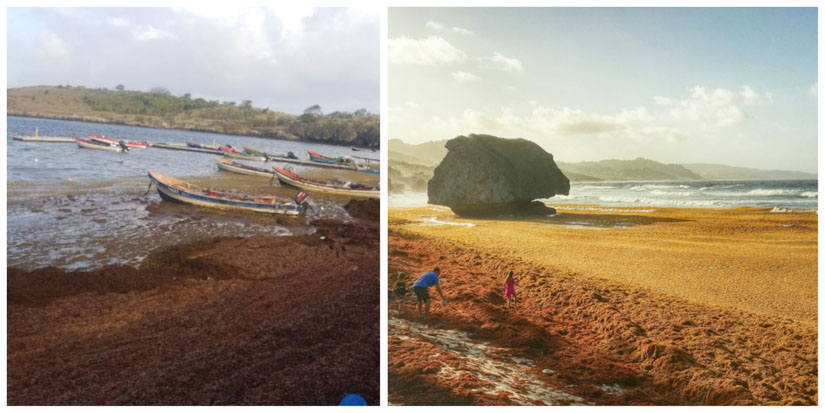USM Partners with University of the West Indies- Barbados to Address the Threat of Sargassum to Caribbean Waters, Islands
Mon, 04/11/2022 - 09:32am | By: Margaret Ann Macloud
 The work of The University of Southern Mississippi (USM) marine research scientists
goes far beyond their “backyard” in the Gulf of Mexico. Dr. Jim Franks, a fisheries
biologist, and Dr. Donald Johnson, a physical oceanographer, are both Senior Research
Scientists in USM’s Center for Fisheries Research and Development (CFRD). The Center
is working with the University of the West Indies (UWI) in Barbados to better understand
the ongoing threat of pelagic Sargassum to the Caribbean islands and on both sides of the tropical Atlantic.
The work of The University of Southern Mississippi (USM) marine research scientists
goes far beyond their “backyard” in the Gulf of Mexico. Dr. Jim Franks, a fisheries
biologist, and Dr. Donald Johnson, a physical oceanographer, are both Senior Research
Scientists in USM’s Center for Fisheries Research and Development (CFRD). The Center
is working with the University of the West Indies (UWI) in Barbados to better understand
the ongoing threat of pelagic Sargassum to the Caribbean islands and on both sides of the tropical Atlantic.
Pelagic Sargassum is a floating marine macroalgae that occurs in the North Atlantic Ocean. It commonly occurs and is described by Franks as “a critically important floating marine habit.” But the vast amount of this algae that has shown up in the Caribbean Sea and along island shorelines since 2011 is overwhelming—think, mounds on the shore that are six feet high at times—and as it degrades, it creates an air quality issue for the people who live and visit there—the sulfurous material reeks of that distinctive rotten egg smell. Coral reefs, mangroves and beach nesting grounds are being overwhelmed. Tourism and fisheries, the dominant economic foundation of the Island nations, are seriously impacted. Local resorts across the region have hired full time workers solely to remove the mountains of Sargassum from their beaches.
“It’s an ongoing, dramatically invasive issue, impacting Caribbean island shorelines and the livelihoods of many island inhabitants, and our work is focused on working collaboratively with UWI marine scientists in an effort to understand why such an event is happening regionally and to help predict future occurrences,” said Franks of the relationship between USM and UWI.
The research is being funded by a grant to USM from the UWI under the leadership of marine fisheries scientist Dr. Hazel Oxenford, a faculty member in the UWI Center for Resource Management and Environmental Studies. Dr. Shelly-Ann Cox and Dr. Oxenford’s graduate student, Kristie Alleyne, recently visited the CFRD at USM for the purpose of information exchange and workshop activities. Their university has been working with USM since the masses of Sargassum first appeared in their waters in overwhelming volumes in 2011, and now, under the guidance of CFRD’s Dr. Johnson, they’re preparing to do this work independently, using the combination of climate related research and fisheries management to keep Caribbean fisheries operational despite the extreme threats Sargassum poses to it.
“Our partnership with USM led to the development of the Sargassum Subregional Outlook Bulletin for the Eastern Caribbean, which provides medium-range (3-monthly) island-scale forecasts of Sargassum influxes,” explained Dr. Cox. “It also provides comment on sector-specific implications for tourism and fisheries stakeholders and includes links to the latest Sargassum publications and innovations. This bi-monthly product is widely distributed in the Caribbean and beyond. Our long overdue visit to the CFRD was very productive and has strengthened our partnership with our colleagues at USM. We now have a roadmap towards sustaining the production of the bulletin. In the future, we hope to collaborate on more transformative Sargassum and fisheries related research projects.”
The USM and UWI researchers currently hypothesize that the cause of this event is attributed to several things, among them: increasing sea water temperature, introduction of nutrients into the region stimulating algae growth, and changing ocean currents. Predicting when it will arrive on various Caribbean shorelines is critical to the fisheries and tourism sectors and vital to the response planning processes undertaken by island authorities. Forecasting models, like how severe weather is tracked, are used in tracking the movements of the Sargassum at sea and determining when it will arrive in various regions.
National Geographic reports that scientists used NASA satellite data to measure the length of the Sargassum invasion: 5,549 miles. Not only are arrivals of large masses of Sargassum along shorelines an overwhelming challenge, but so is the necessary clean-up and disposal of it. Concerted efforts are underway to find uses for the Sargassum once collected with some current level of success.
“The challenge is to extract probabilities of seasonal arrival from known observations of relatively persistent ocean currents,” Johnson said. “As we improve the observational data base and include measurements of Sargassum bloom and mortality, we hope to extend our understanding to yearly variations.”
“We appreciate the opportunity to work collaboratively with our friends and colleagues at the University of the West Indies on this issue of such concern and importance within the Caribbean community, particularly, with regard to our study, the fishing community,” Franks said.